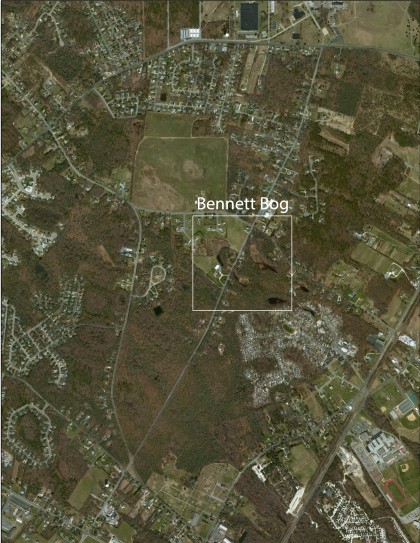
there is nothing distinctive about these bogs, but the plant life living in them is remarkable — R.C. Alexander
Bennett Bogs is a legendary Cape May botany spot. It holds a unique and diverse array of plants many of which normally occur further to the South.
It is a small seasonal wetland complex nestled among residences, farm fields and forest. This has been so ever since the area was first settled, according to Robert C. Alexander who wrote the definitive history of the bogs in the 1951 Bulletin of the Cape May Geographic Society.
The spot was put on the botanical map by the Philadelphia Botanical Club, which embarked on a survey of south Jersey bogs in the early 1900’s. They discovered the showcase plant of the bogs, the snowy orchid – a southern plant that was a surprise to find.
Subsequent botanists discovered a wide array of typically southern plants that had never been found as far north as New Jersey before.
One of the mysteries of the bogs is their uniqueness. The south Jersey landcape is pocked with seasonal wetland depressions but none of these is anything like Bennett Bogs.

This difference is immediately apparent even if you (or me in this case) can’t ID most of the plants – it all just looks quite different from similar open vernal pools. Part of the answer is the soil. There is clay component to the bog soil that is unlike most other vernal pools in the area. This not only changes the soil chemistry but it also changes the hydrology. The clay holds rainwater like a bathtub while most other vernal pools are sandier and drain like sieves into the groundwater.
Alexander describes In his history how the botanical richness of the place was the result of not only soil and moisture but also how the bogs were used by people.
During past decades the area was used in a variety of ways —
In spite, or perhaps because of all this activity the bogs were also a botanist’s paradise. Alexander notes in his history that all three bogs were harvested for hay throughout the period of botanical discovery. He suggests that the plants were benefiting from the annual cutting.
Today two of the three bogs are now owned by conservation groups while the third horseshoe shaped bog (mapped above) is still privately owned.
The bogs are no longer actively used for haying. Because of this, managers must actively mow the bogs to fight the encroachment of trees that would transform this special place into an ordinary swamp forest.
The horseshoe bog has indeed gone that route – now covered in forest and Phragmites with none of the botanical richness it once had.
This begs the question: what did these bogs look like before colonists showed up?
My hunch is that before colonists arrived, water maintained the bogs in a naturally savanna-like state.
We know from ditches at the site and Alexander’s history that efforts were made to drain the bogs.
They nonetheless stayed wet, but probably not wet enough to exclude woody vegetation. At that point the haying took over the job of keeping the woody out.
Now we are in a dry, hayless phase where it takes constant effort to keep the open vegetation of the bogs.
This sort of phenomenon is happening in the Pine Barrens of New Jersey as well, where thin sheets of surface groundwater maintain grasslands. As groundwater withdrawal has brought down the water table, these formerly wet savannas are yielding to woody encroachment.